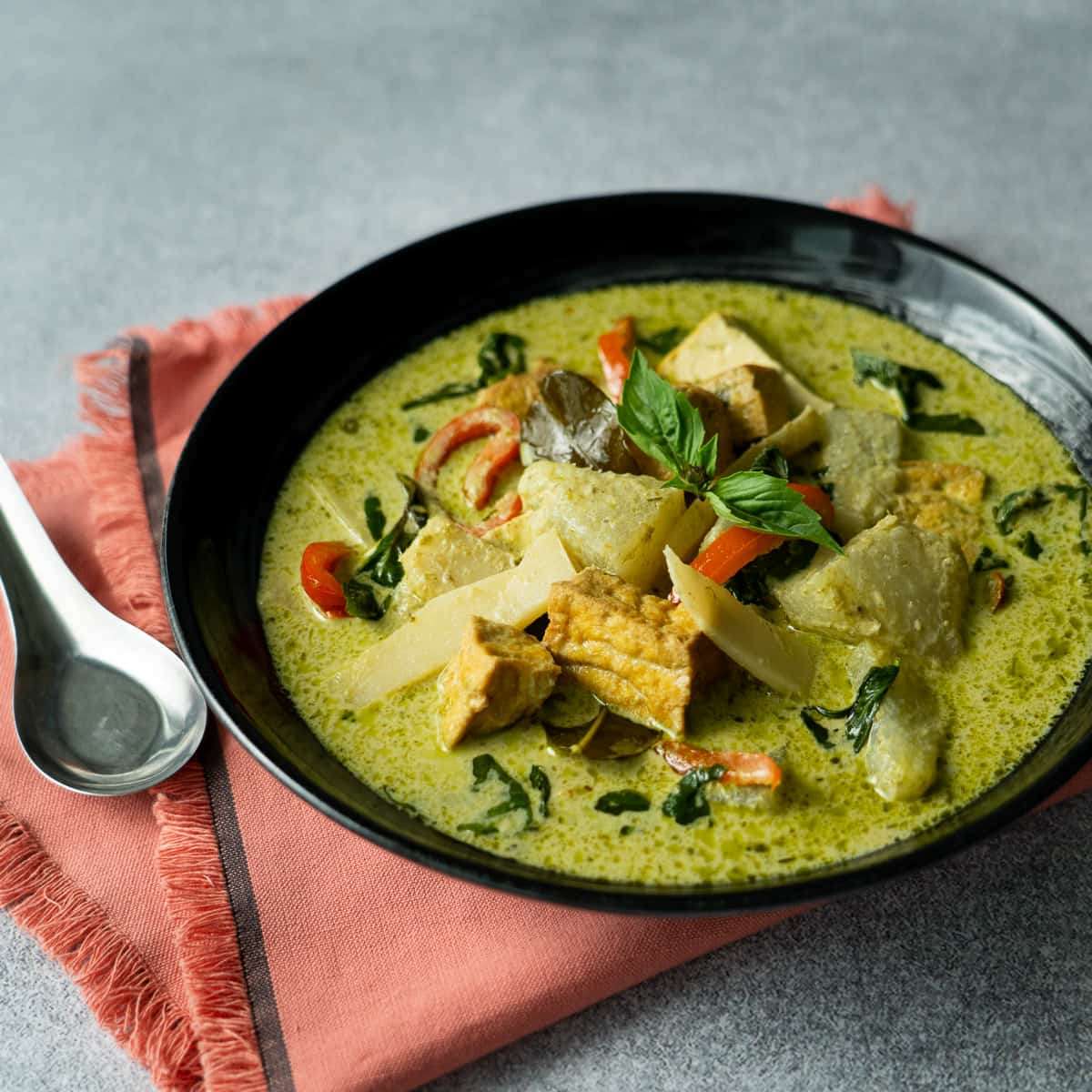
4.9 from 24 votes
Vegan Thai Green Curry
A vegan curry to satisfy even the most hardcore meat eater. Packed with umami and veggies chosen for their chewy, satisfying textures, and secret ingredients that add extra robustness and a vibrant colour to store bought curry paste. For a gluten free curry, simply sub gluten free soy sauce.
Servings: 4 servings
Calories: 331 kcal
Course:
Main Course
Cuisine:
Thai
Ingredients
For an "improved" vegan curry paste
- ¼ cup green curry paste store bought or homemade (see note 1)
- 10-15 leaves of greens such as baby spinach or Thai basil finely julienned (see note 2)
- 1 dried shiitake mushroom medium size, about 5-6 g
- 2 teaspoons Miso paste
For the vegan green curry
- 2 cups coconut milk
- 1 cup water
- 7 oz fried tofu bite-sized pieces (see note 3)
- 5.3 oz canned bamboo shoots strips drained and rinsed well (half a can)
- 9 oz winter melon 1-inch chunks (see note 4)
- 1 tablespoon palm sugar finely chopped, or substitute brown sugar
- 2 tablespoon soy sauce or vegan fish sauce
- 6 makrut lime leaves optional
- ½ red bell pepper julienned (optional for colour)
- 1 cup Thai basil leaves
- jasmine rice for serving
Instructions
For the curry paste
- In a mortar and pestle, grind the leafy greens into a fine paste. Add the miso paste, then use a microplane zester to grate the shiitake mushroom (don’t worry about the stem. You can throw the stem into the curry to extract more umami if you want, but don’t eat it as it’ll be chewy.) Add the curry paste and pound just to mix. You can make this paste in bulk and freeze for later use.Without a mortar and pestle, you can blend the leafy greens with some of the coconut milk that you'll add to the curry. Then simply mix the curry paste, miso and grated mushroom together.
Cup of Yum
For the green curry
- In a heavy-bottomed, large pot, add about ¾ cup of coconut milk and reduce it over medium-high heat until thick; about 5 minutes.
- Reduce the heat to medium and add the curry paste; stir until very thick and coconut oil separates from the curry paste; 3-5 minutes. (If you’ve been at it for a while, and the paste is very thick, but no oil has separated, you can move on; some coconut milk has been processed to prevent separation.)
- Add the rest of the coconut milk and water; bring to a boil. Add the fried tofu, bamboo shoots, winter melon, palm sugar, and about half of the soy sauce. Grab the makrut lime leaves and twist them to bruise and tear before adding them into the pot. Simmer the curry until the winter melon is fork tender; about 10 minutes. When you’re about 1 minute out, add the red bell pepper so it will finish cooking with the winter melon. (If using different vegetables, adjust the cooking time accordingly, but if your vegetables take only a few minutes to cook, let the curry simmer without it for at least 10 minutes before adding, as you want the total simmering time to be a minimum of 10 minutes to allow flavours to mingle.)
- Taste and adjust the seasoning with more soy sauce as needed; you can also add more salt. If it needs more sugar, add granulated or brown sugar at this point to ensure it dissolves quickly. (It should not taste sweet, but the sweetness is added to balance the salt.)
- Turn off the heat and stir in fresh basil, letting it wilt in the residual heat.
- Serve with jasmine rice - and as with most Thai curries, it will taste even better the next day!
Notes
- The amount of curry paste provided is just a guide. You can add more if you can tolerate more heat, or add less next time if you find this too spicy. Adding more will also add more flavour, but keep in mind that curry paste contains salt, so be prepared to adjust the amount of soy sauce accordingly.
- Baby spinach I find is breaks down most easily in a mortar and pestle, but any leafy greens will work.
- You can buy fried tofu at Asian grocery stores. If not available, you can get firm or extra firm tofu and fry it yourself until a golden brown skin forms. Another chewy vegan protein can be substituted.
- Thai eggplant is another great vegetable to use instead of winter melon. You can also sub another softer vegetable such as zucchini.
Nutrition Information
Calories
331kcal
(17%)
Carbohydrates
14g
(5%)
Protein
10g
(20%)
Fat
28g
(43%)
Saturated Fat
23g
(115%)
Polyunsaturated Fat
2g
Monounsaturated Fat
2g
Sodium
660mg
(28%)
Potassium
542mg
(15%)
Fiber
3g
(12%)
Sugar
7g
(14%)
Vitamin A
3519IU
(70%)
Vitamin C
35mg
(39%)
Calcium
137mg
(14%)
Iron
6mg
(33%)
Nutrition Facts
Serving: 4servings
Amount Per Serving
Calories 331
% Daily Value*
| Calories | 331kcal | 17% |
| Carbohydrates | 14g | 5% |
| Protein | 10g | 20% |
| Fat | 28g | 43% |
| Saturated Fat | 23g | 115% |
| Polyunsaturated Fat | 2g | 12% |
| Monounsaturated Fat | 2g | 10% |
| Sodium | 660mg | 28% |
| Potassium | 542mg | 12% |
| Fiber | 3g | 12% |
| Sugar | 7g | 14% |
| Vitamin A | 3519IU | 70% |
| Vitamin C | 35mg | 39% |
| Calcium | 137mg | 14% |
| Iron | 6mg | 33% |
* Percent Daily Values are based on a 2,000 calorie diet.